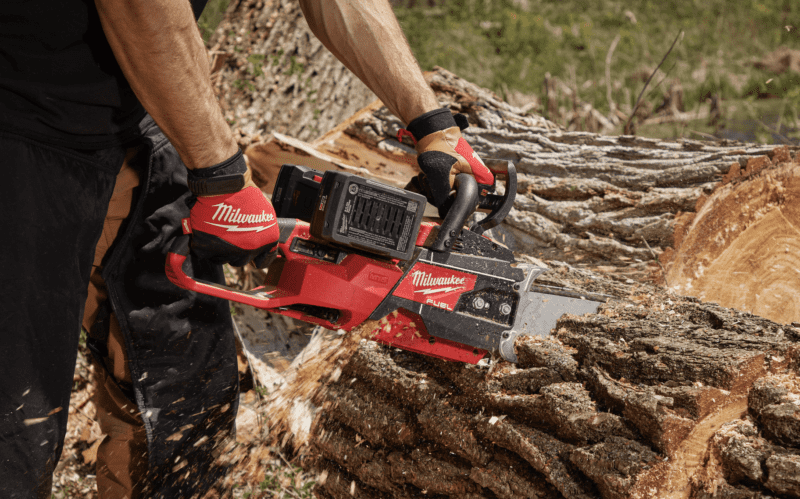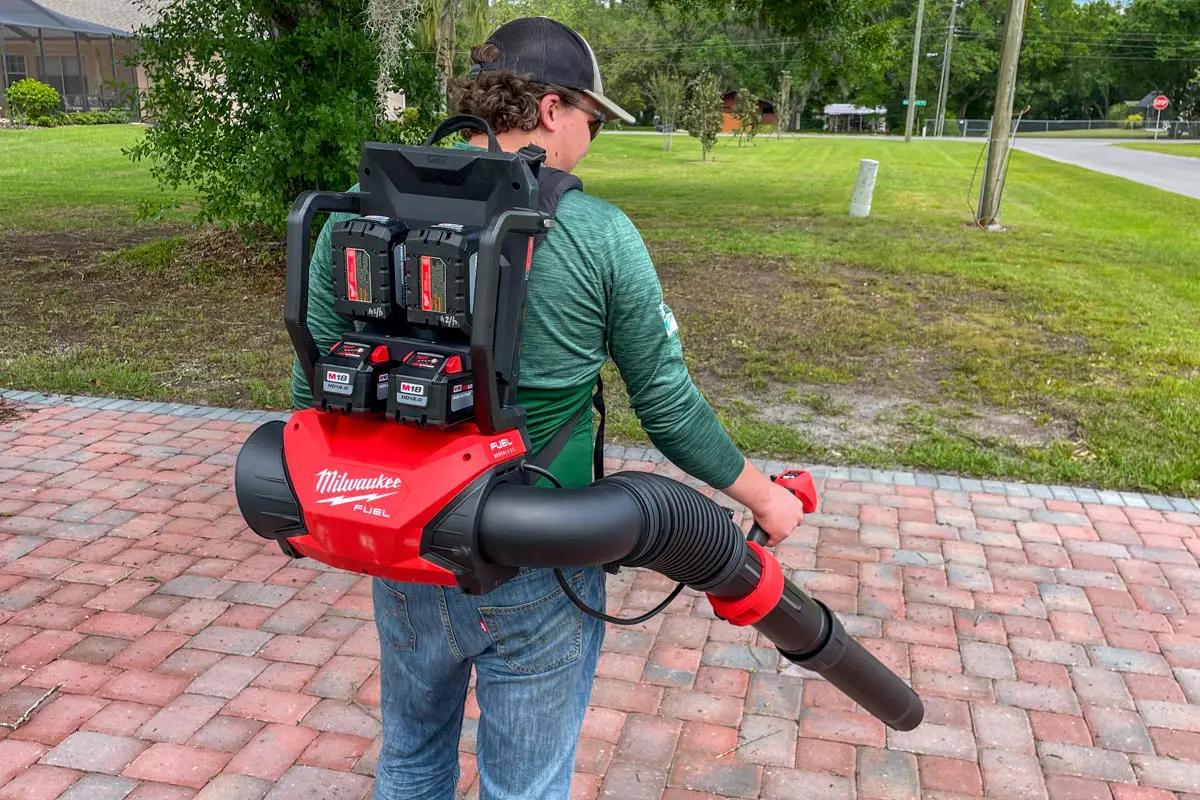Our crew just returned from the 2024 Equip Expo in Louisville, Kentucky where they saw some of the latest and greatest outdoor power equipment. While there, Clint had the opportunity to chat with Bradley Berkman, a Product Manager on the OPE side at Milwaukee Tool, about the future of professional lawn care and landscaping along with Milwaukee’s approach to it.
Milwaukee’s Journey Into Outdoor Power Equipment
In 2024, Milwaukee Tool is celebrating its 100th anniversary. While it could be fun to trace the OPE journey all the way back to 1924, the real jump start happened in 2007 as Milwaukee led the way with lithium-ion batteries and then brushless motors.
For the next 10 years, Milwaukee’s innovation and product development focused on professional tradesmen. From drills to Sawzalls, more and more corded tools became cordless. The M18 RedLithium battery once bragged about producing over 20 amps and today it’s capable of producing well over 100 amp peaks. As battery power began exceeding the performance of what 120V AC could produce, the natural question was… what else can battery power accomplish?
Tradesmen working construction sites and utility started driving the conversation about battery-powered chainsaws and blowers for their work. Being a user-driven company, those talks opened the door to OPE, and around 2017, Milwaukee went all-in with a new business unit specifically for outdoor power equipment.
The initiative included hundreds of new engineers, product managers, regulatory team members, and others to determine how they could disrupt the space in a big way.
It’s no small feat. Starting with what Pros in the field say they need from their equipment, product development includes hundreds of thousands of qualitative and quantitative touchpoints to define the right solutions and get them to the finish line. That initiative and effort hasn’t changed as Milwaukee develops the next generation of battery-powered equipment.
The Current State of Battery-Powered Outdoor Power Equipment
Better By Nature
The vast majority of blower, trimmer, and chainsaw sales over the past 5–7 years have been battery-powered. That’s largely driven by homeowners.
Even though we’ve seen professional-grade outdoor power equipment using battery power for several years, the Pro market has been slower to adopt. Yet, Pros have an even greater incentive to make the switch.
A homeowner only uses their tools weekly, perhaps a couple of times a week, but a landscaper in the professional industry does lawns all day long. The fuel costs add up quickly. Pros stand to really gain from transitioning to battery when you think about how much they can save just in fuel costs alone. Plus, there are fewer maintenance and wearable parts to replace. It’s a huge opportunity for them.
It’s not just cost savings, though. There’s less noise which has a positive effect on your hearing and safety. Most battery-powered equipment has lower vibration, leaving you with less fatigue at the end of the day. Fewer exhaust fumes getting into your lungs is also a good thing for your long-term health.
The Battery Gateway

For homeowners, string trimmers and blowers are often the first lawn care products that open their eyes to battery-powered possibilities. But what about Pros?
According to Berkman, it’s the 20-inch chainsaw for Milwaukee. With almost 6 horsepower gas equivalent power, a common reaction when people try it is, “I had no idea a battery could do that.”
We wouldn’t have been able to enjoy that kind of performance that long ago. It’s only been a couple of years since the industry broke through the 40cc gas equivalent barrier. Milwaukee has picked up some acceleration with products like that 20-inch chainsaw, the 60cc equivalent backpack blower, and the 65cc equivalent MX Fuel backpack blower.
A Two-Phase Conversion
From a high level, convincing Pro landscapers and lawn care crews to transition from gas to battery power happens in a couple of phases.
Tool Capability and Quality Matters

First, they need to know if the tools are any good. The best way to do that is to get them in the hands of Pros so they can feel what it’s like to use them.
You also have to help them understand what kind of performance they’re experiencing. Battery-powered equipment doesn’t sound like gas, and it can have a different feel under load. Using gas equivalent comparisons, such as the M18 Fuel self-propelled lawn mower being able to outperform a 200cc gas model, goes a long way in educating users.
Next Comes Battery Management

Once Pros know the tool can do the job and has the durability to last, the next hurdle is understanding how to manage batteries to get through a day of work. How batteries do you need? How many chargers? Do you bring enough batteries for a full day, take a mid-day break, or charge overnight back at the shop?
Every manufacturer competing in the space has to figure out how to answer those questions.
Unfortunately, some people get a bad taste in their mouth because they tried something like a blower that had high runtime claims but failed to deliver. The manufacturer based it on the lowest possible speed with a big battery that wasn’t the one that came in the kit. The end result is often a disappointed user who won’t continue being a customer moving forward. That experience also makes them more hesitant to invest in battery solutions from other brands.
How Much Battery Power Do You Really Need?
However, if you can start by understanding how much energy you actually need to get through the day, you’re 90% of the way there. The challenge from there is determining how you’re going to charge so you know how many batteries you need. The good news is that it might be as many as you think. It’s common for people to overestimate how much actual trigger time each tool gets over the course of a day.
Eventually, it’s likely we’ll see the majority of electric crews have onboard solutions just to eliminate taking batteries on and off the trailer every night. Users might plug in the trailer to power onboard chargers, or they might recharge a large power storage bank that recharges individual batteries throughout the day.
Milwaukee’s Approach to Power Management
Milwaukee started by studying more than 100 landscaping crews using small data loggers to determine how much each piece of equipment is used. Not only could they see what an average day looks like, but also data across the entire year with its seasonal changes.
That wasn’t the end of it, though. Milwaukee’s team discovered that there’s no one-size-fits-all way to approach the problem. There are wildly different energy needs based on the type of properties you’re serving, where you have access to power, and where you’re working in the US. That set the team developing innovation in a couple of key areas to not only ensure that there’s a solution, but that there’s flexibility to build out your battery system in a way that works for your unique situation.
One of those deals with the challenge of using existing electrical infrastructure in your shop. If you’ve tried charging a large number of batteries at once, you know it can be easy to start tripping breakers.
Milwaukee’s 6-bay daisy chain charger was specifically designed to help you charge up to 60 batteries on a single 15-amp circuit. Previously, they had developed a Packout charger that could handle 18 batteries on a circuit, so developing the ability to connect more chargers was a huge improvement.
By creating innovative and scalable charging solutions, you can avoid the additional expense of paying an electrician to upgrade your system and make transitioning to battery power easier. That’s just one example of how Milwaukee is addressing the very real challenges of making battery power an easier transition for Pros.
It’s About More Than Just the Battery
Certainly, the demands on the battery are a big focus area when developing battery-powered lawn care and landscaping equipment. You need a combination of power delivery, heat management, high capacity, and effective charging. Battery cells, connections, heat sinks, and airflow are all optimized in M18 RedLithium batteries to ensure they can handle the rigors of professional use by landscapers.
Then, you need powerful motors to drive the performance of these power-hungry tools along with the electronics to manage the system.
Even as battery cells are getting more energy dense and motors are becoming more powerful, the next shift is towards more compact, lighter tools that maintain the same or better performance levels.
Even though we’re more than 15 years into the lithium age, it still feels like we’re just getting started. With so many industries relying on lithium-ion technology outside of OPE and power tools, there’s a lot of innovation and development already in the works that will take us to the next levels of what’s possible.
Servicing Battery-Powered Outdoor Power Equipment
Having no carburetor, fuel lines, belts, and other common service touch points is another benefit of battery-powered equipment. Even though there’s much less maintenance to worry about, what happens when you inevitably need service?
Milwaukee intentionally makes its equipment serviceable by users. For example, instead of using soldered connections on components, they use removable pushpin connectors. If that component needs to be replaced, it’s far easier for someone who hasn’t been through an extensive training course.
Whether you don’t want to deal with service yourself or there’s an issue that requires a trained tech, Milwaukee leans on its existing Authorized Service Center network. With dozens of service centers around the country, they’re committed to getting your equipment back in service as quickly as possible.
Predicting the Future of Battery-Powered Outdoor Power Equipment Conversion
Accurately predicting the future is tough—just ask a meteorologist. It’s fun to try, though. When it comes to battery-powered OPE, it’s hard to know when Pros will hit that critical mass and we start to see widespread adoption.
With handheld tools, the power is there, so it’s reasonable to think we’ll see increasing transition quickly for those products.
You also have to keep an eye on regulations. With states like Colorado and California banning small gas engines, there’s a more urgent need for Pros to have larger equipment solutions ready to go.
For other parts of the country, the transition is likely to take more time. Professional crews go through product replacement cycles, and it’s at the point of replacement when you have a chance to make the case for a brushless motor over a gas engine. If you have a product that meets their needs and exceeds their expectations, you’re helping that crew build confidence in battery power.
Final Thoughts
As we look to the future of outdoor power equipment, it’s clear that the industry is convinced it will be battery-powered. Manufacturers such as Milwaukee are making tremendous investments in the research and development of products that can help Pros make the transition.
Even though we’re at a point where the performance can match or exceed gas equipment, there’s no question that those tools have a bigger upfront cost. We mentioned a two-phase approach to making the conversion, but there’s actually a third—helping Pros see the that it makes sense financially over the life of the equipment.
If we can start having that conversation on a widespread level, we’ll be taking the next big step forward in accelerating the adoption of battery-powered lawn care and landscaping equipment.
Many thanks to Milwaukee Tool and Bradley Berkman for taking the time to talk with us and provide insight for this article.



